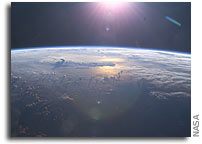Acidic Rain: A Possible Cause of End-Permian Mass Extinction?

Rain as acidic as undiluted lemon juice may have played a part in killing off plants and organisms around the world during the most severe mass extinction in Earth’s history.
About 252 million years ago, the end of the Permian period brought about a worldwide collapse known as the Great Dying, during which a vast majority of species went extinct.
The cause of such a massive extinction is a matter of scientific debate, centering on several potential causes, including an asteroid collision, similar to what likely killed off the dinosaurs 186 million years later; a gradual, global loss of oxygen in the oceans; and a cascade of environmental events triggered by massive volcanic eruptions in a region known today as the Siberian Traps.
Now scientists at MIT and elsewhere have simulated this last possibility, creating global climate models of scenarios in which repeated bursts of volcanism spew gases, including sulfur, into the atmosphere. From their simulations, they found that sulfur emissions were significant enough to create widespread acid rain throughout the Northern Hemisphere, with pH levels reaching 2 — as acidic as undiluted lemon juice. They say such acidity may have been sufficient to disfigure plants and stunt their growth, contributing to their ultimate extinction.
“Imagine you’re a plant that’s growing happily in the latest Permian,” says Benjamin Black, a postdoc in MIT’s Department of Earth, Atmospheric and Planetary Sciences. “It’s been getting hotter and hotter, but perhaps your species has had time to adjust to that. But then quite suddenly, over the course of a few months, the rain begins to sizzle with sulfuric acid. It would be quite a shock if you were that plant.”
Black is lead author of a paper reporting the group’s results, which appears in the journal Geology. Co-authors include Jean-Francois Lamarque, Christine Shields, and Jeffrey Kiehl from the National Center for Atmospheric Research and Linda Elkins-Tanton of the Carnegie Institution for Science.
Lemon juice spike
Geologists who have examined the rock record in Siberia have observed evidence of immense volcanism that came in short bursts beginning near the end of the Permian period and continuing for another million years. The volume of magma totaled several million cubic kilometers — enough to completely blanket the continental United States. This boiling stew of magma likely released carbon dioxide and other gases into the atmosphere, leading to gradual but powerful global warming.
The eruptions may also have released large clouds of sulfur, which ultimately returned to Earth’s surface as acid rain. Black, who has spent several summers in Siberia collecting samples to measure sulfur and other chemicals preserved in igneous rocks, used these measurements, along with other evidence, to develop simulations of magmatic activity in the end-Permian world.
The group simulated 27 scenarios, each approximating the release of gases from a plausible volcanic episode, including medium eruptions, large eruptions, and magma erupted through explosive pipes in the Earth’s crust. The researchers included a wide range of gases in their simulations, based on estimates from chemical analyses and thermal modeling. They then tracked water in the atmosphere, and the interactions among various gases and aerosols, to calculate the pH of rain.
The results showed that both carbon dioxide and volcanic sulfur could have significantly affected the acidity of rain at the end of the Permian. Levels of carbon dioxide and other greenhouse gases may have risen rapidly at the time, in part because of Siberian volcanism. According to their simulations, the researchers found that this elevated carbon dioxide could have increased rain’s acidity by an order of magnitude.
Adding sulfur emissions to the mix, they found that acidity further spiked to a pH of 2 — as acidic as undiluted lemon juice — and that such acidic rain may have fallen over most of the Northern Hemisphere. After an eruption ended, the researchers found that pH levels in rain bounced back, becoming less acidic within one year. However, with repeated bursts of volcanic activity, Black says the resulting swings in acid rain could have greatly stressed terrestrial species.
“Plants and animals wouldn’t have much time to adapt to these changes in the pH of rain,” Black says. “I think it certainly contributed to the environmental stress which was making it difficult for plants and animals to survive. At a certain point you have to ask, ‘How much can a plant take?'”
Life as an end-Permian organism
In addition to acid rain, the researchers modeled ozone depletion resulting from volcanic activity. While ozone depletion is more difficult to model than acid rain, their results suggest that a mix of gases released into the atmosphere may have destroyed 5 to 65 percent of the ozone layer, substantially increasing species’ exposure to ultraviolet radiation. The greatest ozone depletion occurred near the poles.
Cynthia Looy, an assistant professor in integrative biology at the University of California at Berkeley, studies plant environments in the geologic past. Looy, who was not involved in the research, says Black’s findings confirm the theory that this mass extinction was likely caused not by one trigger, but by many.
“We often call this the ‘Murder on the Orient Express’ scenario,” Looy says. “Very often we look for one kill mechanism, but it’s probably everything together. The end-Permian is still a big puzzle for us, and what Ben has done is add really nice pieces to complete this puzzle.”
Going forward, Black hopes paleontologists and geochemists will consider the results as a point of comparison for their own observations of the end-Permian mass extinction. In the meantime, he says he now has a much more vivid picture of that catastrophic time.
“It’s not just one thing that was unpleasant,” Black says. “It’s this whole host of really nasty atmospheric and environmental effects. These results really made me feel sorry for end-Permian organisms.”








